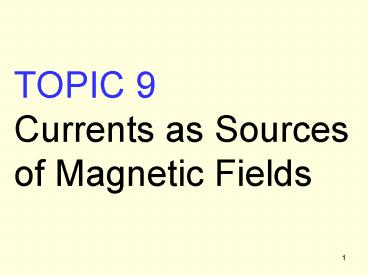Quantum ElectroDynamics PowerPoint PPT Presentation
1 / 14
Title: Quantum ElectroDynamics
1
TOPIC 9Currents as Sources of Magnetic Fields
2
Currents and Fields
- Magnets produce fields which act on magnets.
- Magnets produce fields which act on moving
charges. - Moving charges produce fields which act on
magnets and other moving charges.
3
Moving Charges and Fields
- A moving charge produces a magnetic field which
is - Proportional to magnitude of charge
- Proportional to speed of charge
- Inversely proportional to distance squared
- Perpendicular to planecontaining v and r
- Proportional to sin ?where ? angle betweenv
and r
4
?0
- Constant of proportionality in previous equation
was ?0. - Permeability of space
5
Example 1 In the Bohr model of the hydrogen atom,
an electron moves around a proton in a circular
orbit of radius 5.3?1011 m. The velocity of the
electron is 2.2?106 m s1. What magnetic field
does the electron produce at the position of the
proton?
6
Field due to Electric Current
- Wire length d?, area A, with n carriers/unit
volume - Equivalent to charge dQ n q d?A.
- Drift velocity vd
- Field dB given by
- But I n q A vd
- Therefore
- ? Biot-Savart law
- Integrate over current elements
7
Example 2 Use the Biot-Savart law to find the
magnetic field due to an infinitely long straight
wire. Example 3 Use the Biot-Savart law to find
the magnetic field on the axis of a circular loop
of current-carrying wire.
8
Force between long parallel wires
Field at wire 2 due to current 1 is Field is
perpendicular to current I2, force acting on
length l2 of wireis Force per unit length
is Note equal ( opposite) force on wire 1 as
on wire 2.
9
Force between long parallel wires
Note currents in same directionsattract.
Currents in oppositedirections repel. This is
the practical definition of the Amp. If two wires
carrying same current and separated by one metre
experience a force of 2?107 N per metre of
length the current flowing is 1 A.
10
Ampères Law
- Remember electrostatics
- Coulombs law plus superposition ? E field due to
distributed charge. - May require nasty integrals!
- If have symmetry, easier to use Gausss Law.
- Similarly in electromagnetism
- Biot-Savart law plus superposition ? B field due
to distributed current. - May require nasty integrals!
- If have symmetry, easier to use Ampères Law.
11
Ampères Law
The integral of B?dl around any closed path is
equal to ?0 I, where I is the total current
enclosed by the path. Note Line integral, not
surface integral (as Gauss) Dot product
component of B parallel to dl Must integrate
round loop in correct direction defined by
Right Hand rule Thumb current
direction, fingers ? positive sense of path.
12
Example 4 Use symmetry and Amperes rule to find
the magnetic field around an infinitely long
current-carrying wire.
13
Coils and Solenoids
We have seen field due to a current-carrying
loop. N turns of coil gives N times the
field. Field is non uniform falls away with
distance from coil. Solenoid is a long helical
coil. If length diameter, fieldwithin coil is
nearly uniform. We can find the field
usingAmperes rule. Example 5Determine the
magnetic field inside a solenoid of n turns per
unit length, carrying a current I.
14
Magnetic Flux Gausss Law
Define magnetic flux like electric flux d?B
B?dA No free magnetic poles, so as many lines
of magnetic flux enter any enclosed volume as
leave it. Total magnetic flux through any closed
surface is zero.

